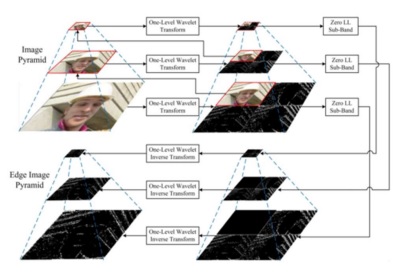Penerapan Wavelet Daubechies pada Teknik Estimasi Gerak Bilateral
Abstract
DVC has the characteristics of lighter encoder performance by transferring the efficiency of the field of motion to the decoder. The characteristics of DVC are similar to FRUC which is a technique to improve the quality of video display from the decoder side by inserting interpolated frames. In this study, multi-resolution bilateral motion estimation based on pyramid wavelets is proposed by comparing the order of wavelets contained in the daubechies wavelet. The parameters compared in this study are PSNR and the computational complexity of the proposed method to improve the quality of the video reconstruction from the decoder side. This study shows that the use of the daubechies wavelet order in the proposed method can obtain sufficient category of PSNR values of db6 with a value of 27.37 dB for video images with moving background characteristics and moving objects, good categories of db7 and db10 with a value of 34.8 dB and 32.06 dB for video images with fixed background characteristics and moving objects, and video images with moving background characteristics and fixed objects. The selection of the wavelet order on the daubechies wavelet can be adjusted to the characteristics of the video image that will be used.
Downloads
References
[2] I. M. O. Widyantara, N. Putu, and W. Yuniari, “Unidirectional Motion Estimation Technique With Full Search Algorithm For Frame Rate Up- Conversion Video,” Int. Conf. Smart Green Technol. Electr. Inf. Syst., no. November, pp. 5–7, 2014.
[3] R. Li, H. Liu, J. Chen, and Z. Gan, “Wavelet pyramid based multi-resolution bilateral motion estimation for frame rate up-conversion,” IEICE Trans. Inf. Syst., vol. E99D, no. 1, pp. 208–218, 2016.
[4] K. Lee, “Adaptive Frame Rate Up-Conversion Algorithms using Block Complexity Information,” vol. 21, no. 8, pp. 813–820, 2018.
[5] S. Yu and J. Jeong, “Multidirectional motion estimation algorithm for frame rate up-conversion,” MATEC Web Conf., vol. 125, p. 05002, 2017.
[6] E. Filtering, R. Li, W. Ma, Y. Li, and L. You, “A Low-Complex Frame Rate Up-Conversion with,” 2020.
[7] Yong Guo, Li Chen, Zhiyong Gao, and Xiaoyun Zhang, “Frame Rate Up-Conversion Method for Video Processing Applications,” IEEE Trans. Broadcast., vol. 60, no. 4, pp. 659–669, 2014.
[8] A. Isberg and J. Jostell, “Frame rate up-conversion of real-time high-defnition remote surveillance video,” 2012.
[9] M. Yoon, S.-H. Nam, I.-J. Yu, W. Ahn, M.-J. Kwon, and H.-K. Lee, “Frame-rate Up-conversion Detection Based on Convolutional Neural Network for Learning Spatiotemporal Features,” 2021.
[10] S. Yu and J. Jeong, “Multidirectional motion estimation algorithm for frame rate up-conversion,” MATEC Web Conf., vol. 125, pp. 2–5, 2017.
[11] D. Park and J. Jeong, “Motion Compensated Frame Rate Up-Conversion Using Modified Adaptive Extended Bilateral Motion Estimation,” J. Autom. Control Eng., vol. 2, no. 4, pp. 371–375, 2014.
[12] A. Barjatya, “Block Matching Algorithms For Motion Estimation,” DIP 6620 Spring 2004 Final Proj. Pap., 2004.
[13] M. Muthia, K. Munadi, and F. Arnia, “Studi Kuantisasi Bin Terhadap Metode Local Binary Pattern dan Local Binary Pattern Variance pada Deteksi Citra Asap,” Karya Ilm. Mhs. Tek. Elektro, vol. 2, no. 3, pp. 31–39, 2017.
[14] I. G. A. Garnita Darma Putri, N. P. Sastra, I. M. O. Widyantara, and D. M. Wiharta, “Kompresi Citra Medis dengan DWT dan Variable Length Code,” Maj. Ilm. Teknol. Elektro, vol. 20, no. 2, p. 187, 2021.
[15] I. G. M. M. Utama Yasa, L. Linawati, and N. Paramaita, “Penentuan Notasi Gamelan Rindik Menggunakan Metode Transformasi Wavelet,” Maj. Ilm. Teknol. Elektro, vol. 17, no. 3, p. 319, 2018.
[16] K. Rajalakshmi and K. Mahesh, “A Review on Video Compression and Embedding Techniques,” Int. J. Comput. Appl., vol. 141, no. 12, pp. 32–36, 2016.
[17] S. S. N. H. Fransiskus Fran, “Prediksi Harga Saham Jii Menggunakan Transformasi Wavelet Diskrit Daubechies,” Bimaster Bul. Ilm. Mat. Stat. dan Ter., vol. 8, no. 4, pp. 659–666, 2019.
[18] Rohima and M. Barkah Akbar, “Wavelet Analysis and Comparison from Coiflet Family on Image Compression,” 2020 8th Int. Conf. Cyber IT Serv. Manag. CITSM 2020, pp. 2–6, 2020.
[19] M. B. Akbar, “Comparison and Analysis several Wavelet from Daubechies Family in Image Compression,” 2020 8th Int. Conf. Cyber IT Serv. Manag. CITSM 2020, pp. 0–3, 2020.
[20] S. Sridhar, P. Rajesh Kumar, and K. V. Ramanaiah, “Wavelet Transform Techniques for Image Compression – An Evaluation,” Int. J. Image, Graph. Signal Process., vol. 6, no. 2, pp. 54–67, 2014.
[21] V. P. Kulalvaimozhi, M. Germanus Alex, and S. John Peter, “Performance Analysis of Image Compression Using LPWCF,” Lect. Notes Data Eng. Commun. Technol., vol. 33, no. Iv, pp. 30–41, 2020.
[22] S. B. N and R. A, “Performance Evaluation of Video Compression Using Different Wavelets and Tensors for Multimedia Applications,” SSRN Electron. J., 2019.
[23] D. R. I. M. Setiadi, “PSNR vs SSIM: imperceptibility quality assessment for image steganography,” Multimed. Tools Appl., vol. 80, no. 6, pp. 8423–8444, 2021.
[24] S. Syamsuryadi and I. Aqil, “Watermarking Video Menggunakan Metode Transformasi Wavelet Diskrit,” J. Ilm. Inform. Glob., vol. 9, no. 2, pp. 90–94, 2019.
[25] T. Maharani, M. A. Zainuddin, and S. Sukaridhoto, “Pengukuran Psnr Pada Transmisi Video Di Kanal Terahertz Menggunakan Qam Modulation,” Klik - Kumpul. J. Ilmu Komput., vol. 7, no. 2, p. 154, 2020.


This work is licensed under a Creative Commons Attribution-NonCommercial-NoDerivatives 4.0 International License.

This work is licensed under a Creative Commons Attribution 4.0 International License




